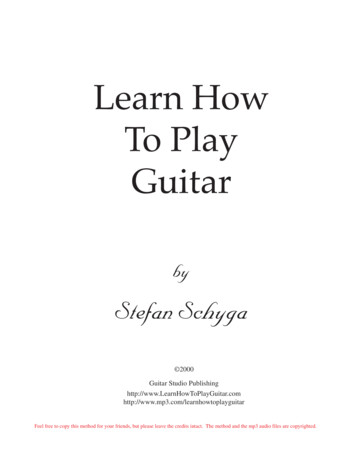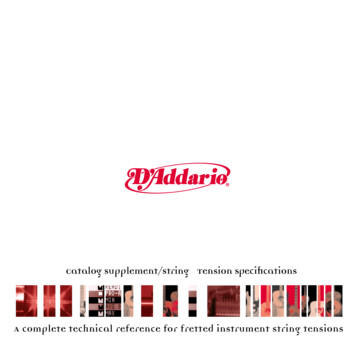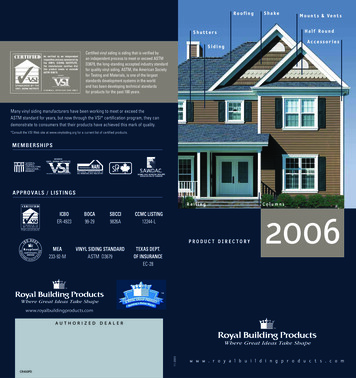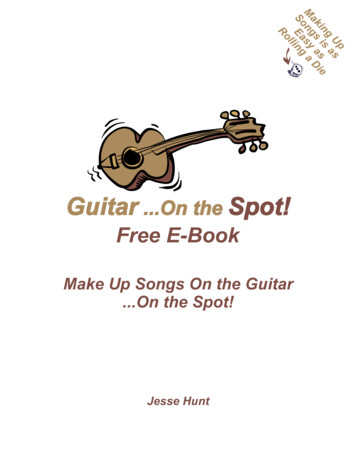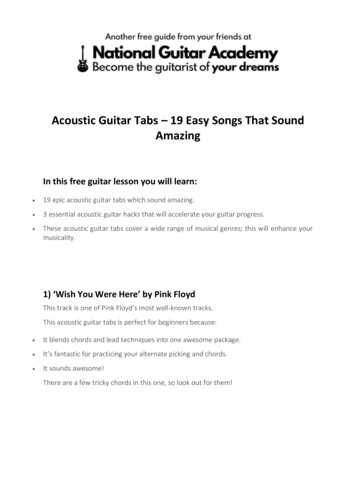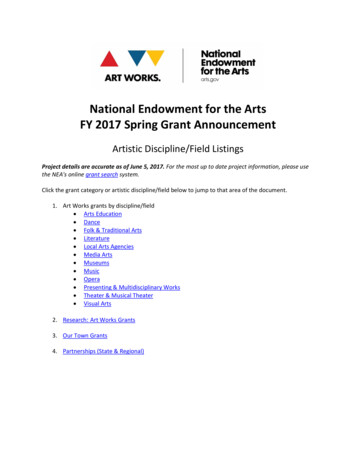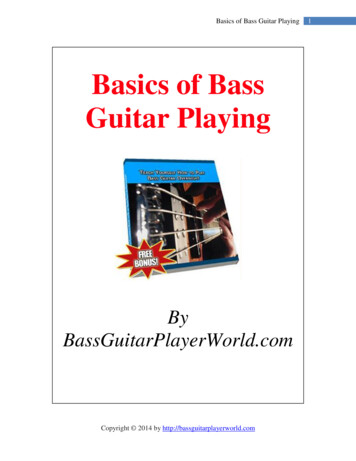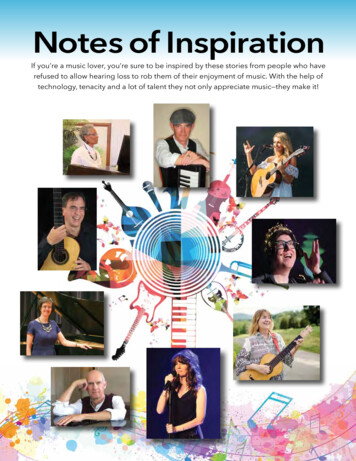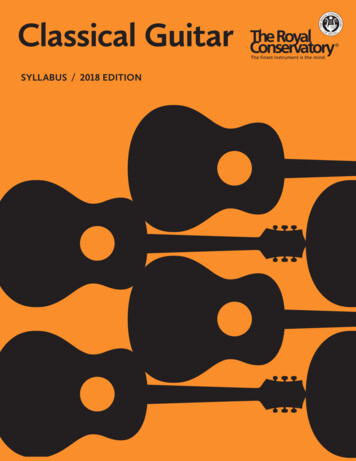
Transcription
Classical GuitarSYLLABUS / 2018 EDITION
SHIN SUGINOMessage from the PresidentThe mission of The Royal Conservatory—to develop human potential through leadership inmusic and the arts—is based on the conviction that music and the arts are humanity’s greatestmeans to achieve personal growth and social cohesion. Since 1886 The Royal Conservatory hasrealized this mission by developing a structured system consisting of curriculum and assessmentthat fosters participation in music making and creative expression by millions of people. Webelieve that the curriculum at the core of our system is the finest in the world today.In order to ensure the quality, relevance, and effectiveness of our curriculum, we engage in anongoing process of revitalization, which elicits the input of hundreds of leading teachers. Theaward-winning publications that support the use of the curriculum offer the widest selection ofcarefully selected and graded materials at all levels. Certificates and Diplomas from The RoyalConservatory of Music attained through examinations represent the gold standard in musiceducation.The strength of the curriculum and assessment structure is reinforced by the distinguishedCollege of Examiners—a group of outstanding musicians and teachers from Canada, theUnited States, and abroad who have been chosen for their experience, skill, and professionalism.A rigorous examiner apprenticeship program, combined with regular evaluation procedures,ensures consistency and an examination experience of the highest quality for candidates.As you pursue your studies or teach others, you become an important partner with The RoyalConservatory in helping all people to open critical windows for reflection, to unleash theircreativity, and to make deeper connections with others.Dr. Peter C. SimonMichael and Sonja Koerner President & CEOThe Royal Conservatory
Contents1: IntroductionAbout Us4Program Overview7The Royal ConservatoryThe Royal Conservatory Certificate ProgramRCM PublishingDigital LearningAdditional Programs44444Practical Certificates and DiplomasTheory Examinations78Practical Examination Requirements8Getting Started5Why Choose The Royal ConservatoryCertificate Program?Examinations OfferedContact UsRegister for an ExaminationExamination Sessions and Registration Deadlines55566What’s New?6RepertoireRepertoire ListsDa Capo Signs and RepeatsMemorizationSubstitutionsSyllabus SubstitutionsTeacher’s Choice SubstitutionsSubstitutions SummaryTechnical RequirementsEtudesTechnical TestsMusicianshipEar TestsSight Reading8899999101010101010102: Level-by-Level RequirementsElementary Certificates11Advanced Certificates58PreparatoryLevel 1Level 2Level 3Level 41114182328Level 9Level 105864Diplomas70Intermediate Certificates33Associate Diploma (ARCT) in Guitar, PerformerAssociate Diploma (ARCT) in Guitar, Teacher7073Level 5Level 6Level 7Level 8333844513: Policies and ReferenceExamination Regulations74Reference77Examination ProceduresCredits and Refunds for Missed ExaminationsStudents with Special NeedsCertificatesTable of MarksExamination ResultsClassification of MarksSplit Level 10 Practical ExaminationsSupplemental sResources for Examination Preparation777779Appendices80Appendix A: Technical Tests ExamplesAppendix B: Musicianship Examples8081Practical Examination Day Checklistfor Students873
CONTENTS1: IntroductionAbout UsThe Royal ConservatoryRCM PublishingThe Royal Conservatory is one of the largest and most respectedmusic education institutions in the world. Providing the definitivestandard of excellence in curriculum design, assessment, performancetraining, teacher certification, and arts-based education and socialprograms, The Royal Conservatory makes a significant impact onthe lives of millions of people globally.As The Royal Conservatory’s publisher, RCM Publishing producesThe Royal Conservatory’s renowned syllabi and related teachingand examining materials for individual instruments, voice, andtheoretical subjects.Notable alumni include:The Digital Learning Program serves to broaden the reach of musiceducation through offering students and teachers online coursesand resources, ensuring ease of access, and maximizing engagementand interactivity to expand and deepen our relationship with musicmakers of all ages. Using the power of technology, and leveragingsome of the best musical minds available, learning with The RoyalConservatory is now available to all. Randy Bachman Gordon Lightfoot Isabel Bayrakdarian Jan Lisiecki Russell Braun Lois Marshall Martin Beaver Sarah McLachlan Measha Brueggergosman Oscar Peterson Adrienne Clarkson Adrianne Pieczonka Bruce Cockburn Gordon Pinsent David Foster Paul Shaffer Glenn Gould St. Lawrence String Quartet Angela Hewitt Teresa Stratas Norman Jewison Shania Twain Diana Krall Jon VickersDigital LearningAdditional ProgramsAdditional programs of The Royal Conservatory are deliveredthrough the following divisions: The Glenn Gould School provides professional trainingin music for gifted young artists at the undergraduate andgraduate levels. The Phil and Eli Taylor Performance Academy for YoungArtists provides supportive, comprehensive training forpromising young musicians aged nine to eighteen.*Visit rcmusic.com to learn more about the history of The RoyalConservatory. The Marilyn Thomson Early Childhood Education Centredevelops innovative early childhood education programs,teacher certification, and digital early childhood educationproducts for use by parents and their children.The Royal Conservatory Certificate Program The Royal Conservatory School provides music classes andprivate lessons for people of all ages and stages of musicalliteracy.The Royal Conservatory Certificate Program provides a recognizedstandard of musical assessment through an effectively sequencedsystem of study and individual student assessments, frompreparatory to advanced levels. More than 100,000 examinationsare conducted annually in over 300 communities across NorthAmerica. Learning Through the Arts supports excellence in publiceducation programs by utilizing the arts to enhance learning. The Performing Arts Division programs superbperformances and events in The Royal Conservatory’s threevenues in Toronto: Koerner Hall, Mazzoleni Concert Hall inhistoric Ihnatowycz Hall, and Temerty Theatre.The College of ExaminersExaminers are highly trained professional musicians andpedagogues from across North America. All examiners completean Adjudicator Certification Program before being admitted to theCollege of Examiners. Professional development and performanceevaluation continues throughout each examiner’s career to ensureconsistent examination standards across North America.*R ead about the College of Examiners, including examiner biographies,at rcmusic.com.4
CONTENTSGetting StartedWhy Choose The Royal ConservatoryCertificate Program?Contact UsThe Certificate Program provides a comprehensive path formusical development, with progressively sequenced requirementsencompassing four main areas: Phone: 416-408-5019 or toll-free 1-800-461-6058Repertoire273 Bloor Street WestToronto ON M5S 1W2Canada Fax: 416-408-3151 Email: candidateservices@rcmusic.ca Each level includes a broad selection of pieces representing avariety of styles and historical periods.United States Regular reviews of the repertoire ensure a balance between thefamiliar canon of teaching repertoire and new and innovativeselections. Phone: toll-free 1-866-716-2223 Fax: 1-866-716-2224 Teachers and students can add favorite pieces throughTeacher’s Choice selections. Email: USaccountservices@rcmusic.ca60 Industrial Parkway, Suite 882Cheektowaga NY 14227-2713Technical Requirements Technical requirements are designed to support the demandsof the repertoire for each level.rcmusic.com Technical tests include patterns based on scales, chords, andarpeggios. Etudes develop technical skills within a musical context.Musicianship Skills A thoughtful and consistent approach to the development ofear training and sight reading provides students with a solidfoundation for independent creative musical explorations. Musicianship skills are developed to support the goals andrequirements of both performance of repertoire and theoreticalconcepts.Musical Literacy The theory concepts recommended for concurrent studyat Elementary levels, and corequisite examinations atIntermediate and Advanced levels support students inacquiring the theoretical and historical knowledge necessaryfor music literacy. Theory examinations are tied to the practical levels,reinforcing concepts encountered in repertoire, technicalrequirements, and musicianship skills.Examinations OfferedPractical ExaminationsAccordion, Bassoon, Cello, Clarinet, Double Bass, Flute, Guitar,Harp, Harpsichord, Horn, Keyboard Harmony, Oboe, Organ,Percussion, Piano, Recorder, Saxophone, Speech Arts and Drama,Trombone, Trumpet, Tuba, Viola, Violin, VoiceWritten ExaminationsTheory; Harmony & Counterpoint; History; Analysis; ARCT,Teacher; ARCT in Piano Pedagogy; ARCT in Composition and/or Theory5
CONTENTSWhat’s New?Register for an ExaminationAll examination registrations should be submitted using the onlineregistration system. Repertoire lists have been expanded to include new workswritten in the last ten years.Examination Sessions and Registration Deadlines The levels of the Certificate Program have been organized intofour progressive stages of musical development: Elementary,Intermediate, Advanced, and Diploma.Practical and written examination sessions take place severaltimes a year at examination centers across North America, in bothCanada and the US. Substitution policies have been clarified, allowing students andteachers more flexibility in choosing repertoire not included inthe Classical Guitar Syllabus, 2018 Edition.Exact dates and deadlines can be found online. Register earlyto avoid disappointment. Late registrations are subject to anadditional fee and may not always be accommodated. Technical tests have been streamlined and the number of keysrequired reduced, allowing students to focus on developingfluency and ease of execution.Examination FeesExamination fees must be paid at registration using a valid creditcard. Current examination fees may be found online. Musicianship requirements (ear tests and sight reading) havebeen revised to support a smooth progression of these skillsfrom elementary to advanced levels.Examination CentersExaminations are conducted in more than 300 communitiesacross North America. Each examination center has a local CenterRepresentative who ensures that students and teachers have asuccessful examination experience. Sight-reading requirements have been introduced starting atthe Preparatory level.Examination SchedulingAll students must verify their examination schedules onlinetwo weeks prior to the beginning of the examination session.Examination schedules will not be mailed. Teachers may verifytheir students’ examination schedules online through their teacheraccount.Students are asked to print the “Examination Program Form”from their account. The program form must be filled out by thestudent and/or teacher, and brought to the examination center forpresentation to the examiner.Students who, for any reason, are unable to attend an examinationshould contact the Center Representative listed on theirExamination Schedule. The Center Representative may be able toprovide an alternate appointment time.6
CONTENTSProgram OverviewAdvanced CertificatesInternationally recognized certificates are awarded for successfulcompletion of each practical and theory examination fromPreparatory to Level 10.A comprehensive certificate may be earned by successful completionof each practical examination and its corequisite examinations forLevels 9 and 10.Comprehensive certificates are awarded to students in Levels5 through 10 for successful completion of both the practicaland corequisite theory examinations. Diplomas are awarded toAssociate Diploma (ARCT) candidates for successful completionof both the practical and corequisite theory minationRequirementTheory ExaminationCorequisiteLevel 9 GuitarLevel 9 Guitar Level 8 Theory Level 9 Harmony(or Keyboard Harmony) Level 9 HistoryLevel 10 GuitarLevel 10 Guitar Level 8 Theory Level 9 Harmony(or Keyboard Harmony) Level 9 History Level 10 Harmony& Counterpoint(or Keyboard Harmony) Level 10 HistorySee the current Theory Syllabus (available online) for furtherinformation regarding prerequisites and corequisites.Practical Certificates and DiplomasElementary CertificatesWhile completion of theory examinations is not required toobtain practical certificates for Preparatory to Level 4, it is highlyrecommended that theory study be concurrent with practical studyat all levels. This table illustrates the correlation of practical levelswith theory orrespondingTheory Level(no examinationrequired)Preparatory GuitarPreparatory GuitarPreparatory TheoryLevel 1 GuitarLevel 1 GuitarLevel 1 TheoryLevel 2 GuitarLevel 2 GuitarLevel 2 TheoryLevel 3 GuitarLevel 3 GuitarLevel 3 TheoryLevel 4 GuitarLevel 4 GuitarLevel 4 TheoryDiplomasThe following table summarizes all prerequisite and corequisiteexaminations required to obtain the Associate Diploma (ARCT)in Guitar, Performer or the Associate diploma (ARCT) in Guitar,Teacher. Prerequisites are indicated with P and corequisites areindicated with C.Candidates must complete prerequisite examinations at least onesession prior to registration.ARCTARCTPerformer TeacherComprehensive CertificatesIntermediate CertificatesLevel 10A comprehensive certificate may be earned by successful completionof each practical examination and its corequisite examination forLevels 5 to 8.PPLevel 8 TheoryPPTheory nationRequirementTheoryExaminationCorequisiteLevel 9 Harmony (or KeyboardHarmony)P*P*Level 9 HistoryPPLevel 5 GuitarLevel 5 GuitarLevel 5 TheoryPPLevel 6 GuitarLevel 6 GuitarLevel 6 TheoryLevel 10 Harmony & Counterpoint (orKeyboard Harmony)Level 7 GuitarLevel 7 GuitarLevel 7 TheoryLevel 10 HistoryPPLevel 8 GuitarLevel 8 GuitarLevel 8 TheoryARCT Harmony & Counterpoint(or Keyboard Harmony)CCARCT AnalysisCCARCT HistoryCC*7 For more information, please see celebratetheory.com.
CONTENTSPractical ExaminationRequirementsTheory Examinations*See the current Theory Syllabus (available online) for detailed theoryexamination requirements.RepertoirePractical studies are supported by theory examinations that promotethe development of musical literacy and encourage an enrichedunderstanding of style and structure. Theory examinations testknowledge of music theory and history, either through an inperson written examination or online.The Classical Guitar Syllabus, 2018 Edition lists the repertoirerequired for guitar examinations. Information given for each itemincludes: the composerOfficial Examination Papers, available at music retailers, arepublished annually by RCM Publishing to aid with examinationpreparation. the title of the selection the larger work of which the selection is a part (whereapplicable) an anthology or collection in which the selection can be found(where applicable) performance directions (where applicable) indicating thesection(s) of a work to be prepared the publisher of a suggested edition (where applicable)Names of publishers are indicated by an assigned abbreviation.Please see p. 77 for a list of publishers with their abbreviations.Repertoire ListsAt each level, students are encouraged to choose a balancedexamination program that includes a variety of musical styles,genres, and tonalities. Repertoire selections for Preparatory toLevel 8 are published in Classical Guitar Series, 2018 Edition:Repertoire and Etudes. The repertoire for Levels 2 to 10 and theAssociate Diploma (ARCT) in Guitar, Performer is divided intolists, according to genre or stylistic period.Level 2List A: Traditional, Renaissance, and Baroque RepertoireList B: Classical, Romantic, 20th-, and 21st-century RepertoireLevels 3 to 6List A: Traditional, Renaissance, and Baroque RepertoireList B: Classical and Romantic RepertoireList C: Late Romantic, 20th-, and 21st-century RepertoireLevels 7 and 8List A: Renaissance RepertoireList B: Baroque and Baroque-style RepertoireList C: Classical and Romantic RepertoireList D: 20th- and 21st-century RepertoireLevel 9List A: Renaissance, Baroque, and Baroque-style RepertoireList B: Classical RepertoireList C: Romantic Repertoire and National StylesList D: 20th- and 21st-century Repertoire8
CONTENTSSubstitutionsLevel 10List A: Renaissance, Baroque, and Baroque-style RepertoireList B: Classical and Classical-style RepertoireList C: National StylesList D: 20th- and 21st-century RepertoireStudents have the option of expanding upon the given lists fortheir level with substitute selections. Official approval of mostsubstitute selections is not required. Substitute selections fallinto two categories: Syllabus substitutions and Teacher’s Choicesubstitutions. Students must comply with the following regulationsregarding repertoire substitutions. A substantial mark deductionmay be applied for substitute selections that do not comply withthe following regulations. (See Substitutions Summary table onthe next page.)Associate Diploma (ARCT) in Guitar, PerformerList A: Works by J.S. BachList B: Classical and Romantic RepertoireList C: Neo-Romantic Repertoire and National StylesList D: 20th- and 21st-century RepertoireList E: Concerto MovementsSyllabus SubstitutionsFor the examination repertoire requirements for Preparatory,please see p. 11; for Level 1, please see p. 14.Students in Levels 1 to 10 may choose substitute selectionsfrom the corresponding list of the level immediately above theirexamination level. For example, a Level 5 List A selection may beperformed in place of a Level 4 List A selection, or a Level 7 etudein place of a Level 6 etude.Da Capo Signs and Repeats When performing repertoire in an examination, studentsshould observe da capo and dal segno signs, unless statedotherwise in the Classical Guitar Syllabus, 2018 Edition. Official approval is not required prior to the examination. Repeat signs should ordinarily be ignored. However, repeatsigns should be observed if indicated in the Classical GuitarSyllabus, 2018 Edition or in the Classical Guitar Series, 2018Edition. Students must ensure that the substitute piece complies withthe genre or stylistic period intended for the list in the level tobe examined (see “Repertoire Lists” on p. 8). For example, aLevel 8 List C selection may be replaced with a selection fromLevel 9 List B or List C. At the Associate Diploma (ARCT) level, repeats may beobserved at the candidate’s discretion, within the allotted time. Syllabus substitutions must be performed according to thesyllabus requirements of the higher level and will be evaluatedat the standard of the higher level.Memorization In Preparatory to Level 2, three memory marks are awardedfor each repertoire selection performed by memory, for a totalof 6 marks. Syllabus substitutions are not permitted for Level 10 Etudes. In Levels 3 to 6, two memory marks are awarded for eachrepertoire selection performed by memory, for a total of 6marks.Students in Levels 3 to 9 may substitute either one repertoireselection or one etude with a work not listed in the Classical GuitarSyllabus, 2018 Edition that is of comparable length, difficulty, andmusical quality to selections in the specified list.Teacher’s Choice Substitutions In Levels 7 to 10, one mark will be deducted for eachrepertoire selection performed with the music. Teacher’s Choice substitutions for repertoire must be ofcomparable stylistic idiom to the corresponding list for whichthey are performed. For the Associate Diploma (ARCT) in Guitar, Performer,memorization is compulsory. Candidates not performing frommemory will receive comments only. Any selection played withmusic will receive a mark of zero. Teacher’s Choice substitutions for etudes may be chosen fromany stylistic period. The mark for the performance of a Teacher’s Choice substituteselection will include an assessment of the appropriateness ofthe choice. Students performing a Teacher’s Choice selection that exceedsthe expected length of a repertoire selection or etude forthe student’s level may be stopped by the examiner once anassessment has been reached. It is the responsibility of the teacher to provide guidanceregarding Teacher’s Choice substitutions.9
CONTENTSSubstitutions SummaryLevelRepertoireSubstitutionEtude Substitution*Levels 1–2 one Syllabussubstitution from thenext higher level one Syllabussubstitution from thenext higher levelMusicianship one Syllabussubstitution from thenext higher levelor one Teacher’s Choicesubstitution for List C one Syllabussubstitution from thenext higher levelor one Teacher’s ChoicesubstitutionEar TestsLevel 10 one Syllabussubstitution from ARCT no substitutions The examiner may play the ear tests on either the guitar or thepiano.ARCT one substitution forList B, C, or D (priorapproval required) not applicable For further details on examination requirements for ear tests,please consult the requirements for each level.Levels 3–9P lease note that in Levels 7 to ARCT, two marks will be deducted fromthe Technical Tests section of the examination for students who use acut-away guitar.Ear tests include melody clapback, melody playback, andidentification of intervals, chords, and chord progressions. Sampleear tests for Preparatory to Level 9 are presented in Four Star Online Ear Training.Sight ReadingFor any substitute selections falling outside these categories,and any substitutions at the Associate Diploma (ARCT) level,students may complete an Examination Substitute Piece RequestForm (available online) by the examination registration deadline.Students are advised to prepare an alternate work in case therequest is denied.Sight-reading tests consist of tapping the rhythm of short excerptsand sight playing of short passages. Students are required to tap one measure of the beat beforeperforming the sight-rhythm excerpt to establish a sense ofpulse and to set the tempo for their performance. Studentsmay choose to tap the beat with one hand or foot. To perform the sight-rhythm excerpt, students may speak therhythm using the syllable of their choice (“la,” “ta,” Kodálysyllables, etc.), count the rhythm (1& 2&, etc.), clap therhythm, or tap the rhythm with their other hand.Technical RequirementsEtudesEtude selections for Preparatory to Level 8 are published in ClassicalGuitar Series, 2018 Edition: Repertoire and Etudes. For further details on examination requirements for sightreading tests, please consult the requirements for each level. Etudes need not be memorized, and no extra marks areawarded for memorization. For further details on examination requirements for etudes,please consult the listings for each level.Technical TestsComplete technical tests for Preparatory to ARCT are published inClassical Guitar Series, 2018 Edition: Technique. The examiner will choose a representative sampling of itemson the technical tests list. Technical tests (scales and arpeggio patterns) must be playedfrom memory, ascending and descending. Students must follow the fingering given in Classical GuitarSeries, 2018 Edition: Technique. Metronome speeds are intended as a guideline for theminimum tempo of each requirement. Students should strive for a legato sound, evenness of tempoand volume, and quality of tone. For further details on examination requirements for technicaltests, please consult the listings for each level.10
CONTENTS2: Level-by-Level RequirementsPreparatoryPreparatory RequirementsCarcassi, MatteoMéthode complète pour la guitare, op. 59, part 3u Sicilienne (no. 22)MarksRepertoire56two selections from the Syllabus ListMemory (3 marks per repertoire selection)25256Technical Requirements24Etudes: one etude from the Syllabus ListTechnical Tests1212Carulli, FerdinandoMéthode complète pour parvenir à pincer de la guitare, op. 241u Waltz (no. 1)u Andante in C Major (no. 2)Costantino, FrédéricSept ballades enchantées DOZu La fin de l’été (The End of Summer)MusicianshipEar TestsClapbackChordsPlayback10424Sight ReadingRhythmPlaying1055Total possible marks (pass 60)100Demillac, YvonImages DOZu Petit poney (Little Pony)Domeniconi, CarloKlangbilder, 1 MRGl Klangbild 5 (Sound Picture 5)Klangbilder, 2 MRGl Klangbild 13 (Sound Picture 13)l Klangbild 16 (Sound Picture 16)Eikelboom, NielsHit the Strings DOZu New Morning (in La guitare dans tous ses états, 1DOZ)RepertoirePlease see “Repertoire” on p. 8 for important information regardingthis section of the examination.Ferrer, Joséu Ejercicio (in First Repertoire for Solo Guitar, 1 FAB)Students must prepare two contrasting selections by differentcomposers from the following list. Three memory marks areawarded for each repertoire selection that is performed by memory.Gagnon, Claudeu Carrousel GAGBullets used to denote selections for examination purposes:l one selectionu selection is found in Classical Guitar Series, 2018 Edition:Hamilton, Robertu Promenade HLTPreparatory Repertoire and EtudesLambert, Florianu Danse des îles (Dance of the Islands) (in La guitarreenchantée: Pièces très faciles, 1 DOM)Barreiro, ElíasClassical Guitar Method, 1 WILl Exercise 13Le Roy, AdrianTiers livre de tabulature de guiterreu Bransle de PoitouBélanger, MarcPiècettes DOZl Dialogue (in La guitare dans tous ses états, 1 DOZ)u Petit bluesMcFadden, Jeffreyu Tea in Picardy JMFu Venus Beam JMFBell, ShawnElementary Studies, 2 DOZl Contentmentu SciapodusMertz, Johann KasparSchüle für die Gitarreu First Exercise on the E StringNeusidler, HansDas ander Buch: Ein new künstlich Lautten Buchu Dutch Dance with repeatsBrown, JamesShort Pieces and Studies, 1 JMBl A Distant Twang (no. 8)11
CONTENTSLEVELPreparatoryOgawa, TakashiPetit album évocateur et facile DOZu Oasis-ExpressBell, ShawnElementary Studies, 2 DOZu A Simple DialogueElementary Studies, 3 DOZu NinouRak, ŠtěpánJeux sur six cordes LEMl Chansonettel Chanson bohémiennel Chanson slovaquel FuriantBrown, JamesShort Pieces and Studies, 1 JMBl StudyCamisassa, Claudiou À la manière bulgare (In Bulgarian Style) (in Laguitare dans tous ses états, 2 DOZ)Shearer, AaronClassic Guitar Technique, 3rd ed., 1 ALFu Moorish DanceCavazzoli, GermanoAmica chitarra RICl Buongiorno (Good Morning)Smith Brindle, ReginaldGuitarcosmos, 1 OTTu Aeolian ModeEikelboom, NielsHit the Strings DOZu CabdriverSummers, Richard12 Pieces for Guitar SMRl Aeolian SightingsA Contemporary Method for Classical Guitar, 2 SMRu “Eight”A Contemporary Method for Classical Guitar, 3 SMRu The Carousel Waltzu DreamsIannarelli, Simone20 études faciles DOZl White HorseJackman, Richard MilesLyrical Studies JKNu Lyrical Study No. 4u Lyrical Study No. 9u Lyrical Study No. 14Viard, Brunol À la cour d’Aliénor (in La guitare dans tous ses états, 1DOZ)Leclercq, Norbertl Dune (in La guitare dans tous ses états, 2 DOZ)Zenamon, JaimeEpigramme, 1 MRGl Torito (no. 7)l Waltz (no. 2)McFadden, Jeffreyu The Flask JMFSagreras, JulioPrimeras lecciones de guitarra RICu Lesson 46u Lesson 48u Lesson 61u Lesson 62Technical RequirementsPlease see “Technical Requirements” on p. 10 and “Appendix A”on p. 80 for important information regarding this section of theexamination.Shearer, AaronClassic Guitar Technique, 3rd ed., 1 ALFu Etude in A Minor (no. 6)u Prelude in E Minor (no. 10)EtudesStudents must prepare one etude from the following list.Bullets used to denote selections for examination purposes:Smith Brindle, ReginaldGuitarcosmos, 1 OTTl Arpeggio Study No. 1l one selectionu selection is found in Classical Guitar Series, 2018 Edition:Preparatory Repertoire and EtudesSor, FernandoIntroduction à l’ étude de la guitare, op. 60u Pour trouver les notes 1 (no. 1)Traditionalu Ukrainian MelodyBarreiro, ElíasClassical Guitar Method, 1 WILl Exercise 15l Exercise 1712
CONTENTSLEVELPreparatoryTechnical TestsThe examiner will choose a representative sampling of items on the technical tests list.The examiner may request scales in either free stroke or rest stroke, using im/mi or ma/am right-hand finger combinations.Scales and arpeggio patterns must be played from memory, ascending and descending. Each scale is to be followed by the tonic (I) chord.Students must follow the fingering given in Classical Guitar Series, 2018 Edition: Technique.KeysRangeNote ValuesTempoScalesC majorDiatonicA minor (harmonic)1 octave 801 octave 56E minor (melodic)A minor (melodic)TremolandoG majorE minor (harmonic)Arpeggio Patterns1. p–m–i triplet pattern2. p–i–m triplet pattern 693. p–a–i triplet pattern4. p–i–a triplet patternMusicianshipPlease see “Musicianship” on p. 10 and “Appendix B” on p. 81 forimportant information regarding this section of the examination.KeysApproximate Lengthtonic, mediantC, G majorA minorfour notesSight ReadingEar TestsRhythmClapbackFor a given rhythm, students will be asked to:Students will choose to clap, tap, or sing the rhythm of a shortmelody after the examiner has played it twice. The examinerwill identify the time signature and count one measure beforebeginning.Time SignaturesBeginning NoteNote Values Tap a steady beat with their hand or foot for one measure. Continue tapping while speaking, tapping, or clapping thegiven rhythm. A steady pulse and metric accentuation areexpected.Approximate LengthTime Signaturetwo measuresNote ValuesApproximate Lengthtwo measuresChordsStudents will be asked to identify the quality (major or minor) of atriad after the examiner has played the first five notes of a major orminor scale followed by the tonic triad in solid/blocked form once.ChordsPositionmajor and minor triadsroot positionPlayingStudents
Associate Diploma (ARCT) in Guitar, Performer 70 Associate Diploma (ARCT) in Guitar, Teacher 73 3: Policies and Reference . Visit rcmusic.com to learn more about the history of The Royal Conservatory. . and resources
